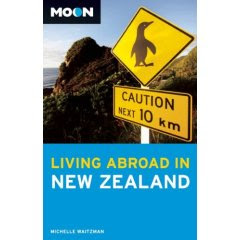Long hiking trails capture the imagination of many, but few of us ever manage to make the commitment (physically, mentally and financially) to complete a route like the Appalachian Trail, the Pacific Crest Trail or the Haute Route through the Pyrenees. These trails are the gold standard for long distance hikers, and now New Zealand has finally joined that elite club.
Te Araroa is a route that allows hikers to literally walk the whole of New Zealand, from the lighthouse of Cape Reinga at the northern tip, to the iconic signpost of Bluff in the far south. It’s a 3,000km journey through a huge variety of landscapes and conditions, and clearly not for the faint of heart.
The route has been a long time in the making, but was finally “officially” opened a few weeks ago. To coincide with this, a guide book has been published as a companion to the trail.
Random House was nice enough to send me a copy of the book, so this is actually a two-fold review; first a book review and second a review of the trail itself.
About the Book:
Te Araroa was written by Geoff Chapple, who has played a huge role in the struggle to make the trail a reality. Geoff likely knows more about this trail than anyone else on the planet, so who better to create the guide!
The book is not something you would use while actually hiking Te Araroa – but more likely as inspiration, background and planning material. The maps in the book give you a good idea of the route and topography of each section, but are not detailed enough to use for navigation. The book is also heavy and glossy, and as all through-hikers know, every ounce counts!
The book begins with a bit of background on hiking and trails in New Zealand, before outlining the long history of the creation of a national trail. It also provides general advice about tramping in New Zealand, about how long a through-hike is likely to take (120-160 days), and about the best times to plan a long section or through-hike.
There is also a good summary of the trail’s shortcomings, such as sections which are not quite complete and where a detour is necessary, as well as trailheads on the opposite banks of large rivers where crossing directly is not advised.
The rest of the book takes readers through the route region by region and section by section. This is especially useful for section hikers or even day hikers as each section includes notes on distance, difficulty, campsites and/or huts, and start and end points. Directions to the nearest road end or town are often included. Each seciton also refers to map numbers. These are maps available to download from the Te Araroa Trust (TAT) website. It would have been helpful to also include Land Information New Zealand topographic map numbers, as many Kiwis already have these and could use them instead of downloading and printing the TAT maps.
Each section includes a 3D map showing the route as well as any roads it crosses or approaches. Lots of colour photos help readers to get a look at the terrain and scenery in different parts of the country. Descriptions of the route give readers an idea of where they need to go, what to look out for, and what the terrain will be like. Historical and cultural information rounds things out and gives readers more context about the trail and New Zealand in general.
As with any guide book, it can never be accurate for long. Trails change, accommodation providers come and go, and information is only reliable for a short time. But the book acknowledges this and encourages readers to check the TAT website for updates before setting out.
Overall, Geoff Chapple’s book is an excellent first resource for anyone planning to walk New Zealand’s long trail, Te Araroa. If you’re a dedicated through-hiker, it will get you inspired and starting to plan your timing and logistics. If you’re a section hiker or tourist, it will help you to find walks that suit your skills and the kinds of landscapes you’re hoping to experience. And for anyone who has walked the trail, it’s a great, colourful souvenir.
While widely available in New Zealand, the book does not appear to be stocked by Amazon.com or Barnes & Noble according to their websites (although Chapple’s 2003 book also titled Te Araroa is available, so don’t be confused.) To purchase from outside NZ, ask your local retailer or buy online (there will be international shipping charges) from www.fishpond.co.nz or www.mightyape.co.nz.
About the Trail:
Like so many outdoors enthusiasts in New Zealand, I have been waiting and hoping that Te Araroa would one day be a reality. Seeing the the trail officially opened made my heart sing. But Te Araroa is unique among long trails in many ways – and while some will love these differences, others may be disappointed. Let me be clear that I have not walked Te Araroa (except a few short sections) so don’t rely on my review as a planning tool.
The first potential issue people will point out is that the trial is not completely in wilderness. It passes through towns and cities as it goes. This makes resupplying and using a “bounce box” easier, as you don’t have to leave the trail to find supermarkets, outdoors suppliers, post offices or whatever else you need. But this does mean that it’s less of a total escape from civilization than something like the Appalachian Trail. I personally feel there’s too much roadside walking included in the route, especially on the North Island. But this may decrease as more connecting trails are completed over time.
Also, it’s not a hike all of the way through. The official route includes a paddling section along the Wanganui River. This may not appeal to everyone, and adds the complication of renting a canoe and arranging for it to be dropped off and picked up. Some through-hikers, however, might enjoy the variety this provides. Others may deviate from the planned route and find a way to cover the distance on foot.
Accommodation options are a bit spotty along the full route. In many cases, New Zealand’s excellent back country hut system provides plenty of shelter. In some areas, however, there are no huts and it will be necessary to pitch a tent or tarp. Then of course there are the towns and cities, where you may need to find private accommodation for the night. If the trail gains enough popularity, I suspect locals will start offering cheap places to pitch a tent, or bunkhouses on their farms or something. Huts are quite plentiful along the South Island portion of the trail, so through-hikers may be able to stop carrying a tent (but always carry some emergency shelter) after completing the North Island.
The trail mostly follows marked tracks so moderately skilled and fit trampers should be able to complete the trail. There are a few sections labelled as “routes” meaning that there may not be markings along the way and map and compass navigation skills are likely needed.
Te Araroa is an amazing accomplishment and mostly due to the efforts of tireless volunteers who believed they could make it happen. New Zealand has some of the most diverse, beautiful and breath taking wilderness in the world, and to be able to see the entire country on foot is a privilege many of us would love to experience. While I don’t see a 3000km through-hike in my future, I do hope to chip away at it bit by bit as time allows.
For detailed information about Te Araroa, including maps, trail notes, advice and much more, visit www.teararoa.org.nz.








